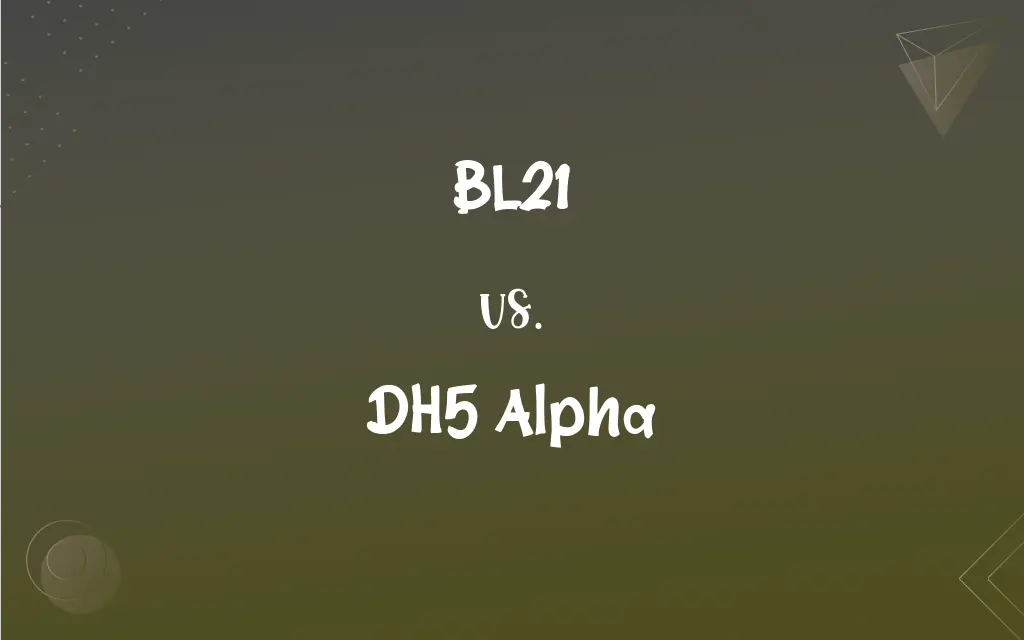BL21 vs. DH5 Alpha: What's the Difference?
By Harlon Moss & Janet White || Published on April 24, 2024
BL21 is a strain of E. coli used for protein expression due to its lack of the lon and ompT proteases, while DH5 Alpha is preferred for cloning tasks given its high transformation efficiency and genetic stability.

Key Differences
BL21 is a bacterial strain engineered for protein production, lacking certain proteases that degrade proteins, making it ideal for expressing recombinant proteins. DH5 Alpha, on the other hand, is optimized for cloning purposes, featuring high efficiency in DNA uptake and genetic stability, which is crucial for maintaining cloned DNA sequences intact.
BL21's advantage lies in its robustness in expressing proteins that might be toxic to other strains, thanks to the absence of lon and ompT proteases. This characteristic allows researchers to produce a wide range of proteins, including those that are difficult to express in other systems. DH5 Alpha, however, shines in its ability to incorporate and replicate plasmid DNA, thanks to its recA1 and endA1 mutations, which enhance plasmid yield and quality.
The use of BL21 is often preferred in industrial and research settings where the goal is to produce large quantities of proteins for pharmaceuticals, research, and industrial processes. DH5 Alpha is the go-to for molecular cloning, especially in the initial stages of constructing genetic libraries or plasmid vectors due to its high transformation efficiency.
In terms of genetic engineering applications, BL21's design is focused on overcoming the challenges of protein production, such as protein degradation and toxicity. DH5 Alpha's features, including its genetic markers (such as lacZΔM15 for blue/white screening), facilitate easier selection and identification of successful cloning events.
BL21 is often used with specific plasmids that contain a T7 promoter for protein expression, DH5 Alpha is versatile in cloning applications, compatible with a wide range of plasmids. This flexibility makes DH5 Alpha a fundamental tool in gene cloning and plasmid propagation before protein expression experiments.
ADVERTISEMENT
Comparison Chart
Primary Use
Protein expression
Cloning
Proteases
Lacks lon and ompT
Not specifically deleted
Genetic Stability
Designed for protein stability
High, suitable for cloning
Transformation Efficiency
Moderate
Very high
Special Features
Ideal for toxic protein production
RecA1 and endA1 mutations enhance DNA stability
ADVERTISEMENT
BL21 and DH5 Alpha Definitions
BL21
BL21 is used in both research and industrial applications.
BL21 strains are pivotal in producing enzymes for industrial processes.
DH5 Alpha
DH5 Alpha includes lacZΔM15 for blue/white screening.
Successful cloning in DH5 Alpha can be visually confirmed through blue/white screening.
BL21
BL21 is suited for expressing toxic proteins.
Proteins toxic to other strains are often expressed successfully in BL21.
DH5 Alpha
DH5 Alpha is a versatile E. coli strain for cloning.
DH5 Alpha cells are the standard choice for constructing plasmid libraries.
BL21
This strain is compatible with T7 promoter-based systems.
BL21 cells are transformed with plasmids containing the T7 promoter for specific protein production.
DH5 Alpha
It features high transformation efficiency.
DH5 Alpha can uptake DNA at a high rate, making it ideal for cloning experiments.
BL21
BL21 is a strain of E. coli for efficient protein expression.
BL21 cells are often used to express recombinant proteins for pharmaceutical research.
DH5 Alpha
DH5 Alpha has genetic modifications for plasmid stability.
The recA1 mutation in DH5 Alpha enhances the stability of cloned DNA.
BL21
It lacks certain proteases, enhancing protein yield.
The absence of lon and ompT in BL21 prevents the degradation of expressed proteins.
DH5 Alpha
It is widely used for plasmid propagation.
Before protein expression, plasmids are often propagated in DH5 Alpha cells.
FAQs
What makes BL21 special for protein expression?
BL21 is engineered to lack certain proteases, making it ideal for producing intact, functional proteins.
Is DH5 Alpha suitable for protein expression?
DH5 Alpha can be used for protein expression but is less efficient compared to strains specifically designed for that purpose, like BL21.
Why is DH5 Alpha preferred for cloning?
Its high transformation efficiency and genetic modifications make it highly suitable for cloning and maintaining plasmid integrity.
What role does the T7 promoter play in BL21's protein expression?
The T7 promoter allows for high-level, inducible protein expression in BL21 when used with compatible plasmids.
Can BL21 be used for cloning?
While possible, BL21 is not the preferred choice due to its specialized design for protein expression.
What are the key genetic differences between BL21 and DH5 Alpha?
BL21 lacks the lon and ompT proteases, while DH5 Alpha has mutations like recA1 and endA1 for enhanced DNA stability and cloning efficiency.
How do recA1 and endA1 mutations in DH5 Alpha aid in cloning?
These mutations enhance plasmid stability and prevent unwanted recombination, improving cloning efficiency and reliability.
What makes DH5 Alpha a popular choice for molecular cloning?
Its high transformation efficiency, genetic stability, and features like blue/white screening make it highly versatile and reliable for cloning.
Why is transformation efficiency important in cloning?
High transformation efficiency, like that of DH5 Alpha, increases the likelihood of successful DNA uptake and cloning.
What types of proteins are typically expressed in BL21?
BL21 is used to express a wide variety of proteins, including those with therapeutic, industrial, or research applications.
Can BL21 be used with any plasmid for protein expression?
BL21 is typically used with plasmids that have a T7 promoter for efficient protein expression.
What precautions should be taken when expressing toxic proteins in BL21?
Although BL21 is designed for such tasks, conditions should be optimized to ensure cell viability and protein yield.
What is the significance of the lacZΔM15 mutation in DH5 Alpha?
This mutation allows for blue/white screening, a straightforward method for identifying successful cloning.
How does the lack of lon and ompT proteases in BL21 benefit protein expression?
This absence prevents the degradation of expressed proteins, increasing the yield of intact, functional proteins.
Can DH5 Alpha be used for expressing toxic proteins?
DH5 Alpha is less suited for expressing toxic proteins compared to BL21, which is specifically designed to handle such challenges.
What is blue/white screening in DH5 Alpha?
Blue/white screening is a technique facilitated by the lacZΔM15 mutation in DH5 Alpha, allowing researchers to distinguish between cells with and without successfully cloned plasmid DNA.
How do BL21 and DH5 Alpha contribute to biotechnology and research?
BL21 facilitates the production of proteins for various applications, while DH5 Alpha supports cloning and genetic engineering, making them essential tools in biotechnology and research.
How do researchers choose between BL21 and DH5 Alpha for their experiments?
The choice depends on the experiment's goal: BL21 for protein expression and DH5 Alpha for cloning and plasmid propagation.
How does the absence of certain proteases in BL21 affect its use in industrial applications?
This trait makes BL21 highly effective for producing large quantities of proteins with industrial applications, such as enzymes.
Why is genetic stability important in cloning strains like DH5 Alpha?
Genetic stability ensures that the cloned DNA remains unchanged during propagation, crucial for reliable experimental outcomes.
About Author
Written by
Harlon MossHarlon is a seasoned quality moderator and accomplished content writer for Difference Wiki. An alumnus of the prestigious University of California, he earned his degree in Computer Science. Leveraging his academic background, Harlon brings a meticulous and informed perspective to his work, ensuring content accuracy and excellence.
Co-written by
Janet WhiteJanet White has been an esteemed writer and blogger for Difference Wiki. Holding a Master's degree in Science and Medical Journalism from the prestigious Boston University, she has consistently demonstrated her expertise and passion for her field. When she's not immersed in her work, Janet relishes her time exercising, delving into a good book, and cherishing moments with friends and family.






































































